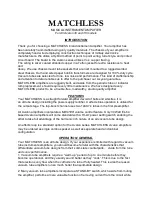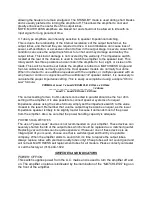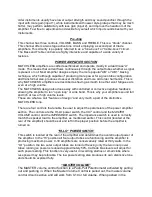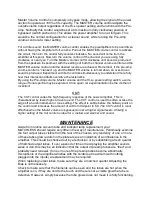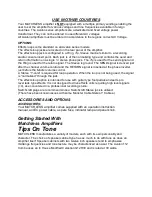
STAND-BY:
This switch serves as a mute for the amplifier, and is used when changing or unplugging a
guitar cord or taking breaks, especially if volume control setting are to be set and left.
Additionally, the
stand-by
mode allows the amplifier to cool down before shutting off the AC
power switch, extending the life of the output tubes. Substantial amounts of current flow
through the output tubes whenever the amplifier is
operational
, even with
no signal from an
instrument
!
PRECAUTION! Cathode biased class A amplifiers do not like to “idle” for prolonged periods.
These amplifiers draw more current idling than they do while being played. Use the stand-
by mode or turn the amplifier off if you are not going to play for a while. Save your tubes!
ABOUT THE FUSE!
Your MATCHLESS amplifier employs a line safety fuse for protection against damage. The
line fuse offers protection against irregularities in an A.C. source, tube failure, component
failure, severe overload to the output amplifier, and other conditions that prove unsafe or
damaging to the amplifier. If an amplifier blows a line fuse, an investigation into its cause is
required. Correct any problems that may be found before putting the amplifier back in
service.
Never replace a line fuse with one of a higher amperage rating! Not only is it unsafe,
but it may leave your amplifier unprotected in the event of a tube or component
failure and voids your warranty.
Use this chart to determine the correct fuse type for your amplifier:
C-30 Chassis (USA) 3AG size 3 Amp rating
C-30 Chassis (Japan) 3AG size 3 Amp rating (Slo-Blo)
C-30 Chassis (Europe) 3AG size 2 Amp rating
For amplifiers designed to operate at non-standard voltages, the required fuse size and
rating
will appear on the manufacturer’s tag affixed to the inside of the amplifier cabinet, or
at the fuse holder on the chassis. When in doubt, consult your dealer or contact the factory.
If you are traveling with your amplifier, and are uncertain about the voltage requirements
and fuse type, please contact the factory. In some countries the line voltage may vary
slightly from the voltage at which an amplifier may be set. This may require modification of
the fuse rating.
In most cases the Rectifier Tube and or Power Tubes that have gone bad will be the cause
of your fuse blowing. Always have spare tubes and spare fuses on hand when using your
amplifier.
PREAMPLIFIER SECTION
Your MATCHLESS amplifier is a Single Channel Circuit utilizing two
12AX7’s one is for
input and the other is the cathode follower for tone.
INSTRUMENT INPUTS:
Your MATCHLESS Avalon amplifier has two inputs one High Input and One Low Input. The
purpose of having two inputs is that the upper input (input 1) provides more gain a brighter
top end. The lower input will reduce the volume slightly and warm up the top end, making
the signal less bright. Instrument pickups vary in signal strength and the user may find one
input offers a better
match
than the other, and this may vary among instruments. As a rule,

